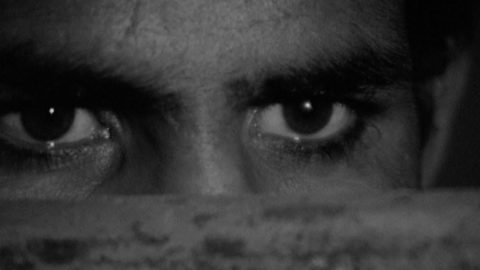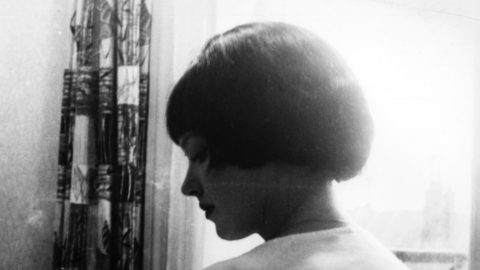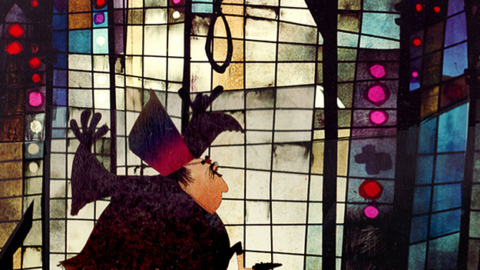Cinema ’67 Revisited: New York Film Festival
In my 2008 book Pictures at a Revolution, I approached the dramatic changes in movie culture in the 1960s through the development, production, and reception of each of the five nominees for 1967’s Best Picture Academy Award: Bonnie and Clyde, The Graduate, In the Heat of the Night, Guess Who’s Coming to Dinner, and Doctor Dolittle. In this biweekly column, I’m revisiting 1967 from a different angle. As the masterpieces, pathbreakers, and oddities of that landmark year reach their golden anniversaries, I’ll try to offer a sense of what it might have felt like to be an avid moviegoer 50 years ago, discovering these films as they opened.
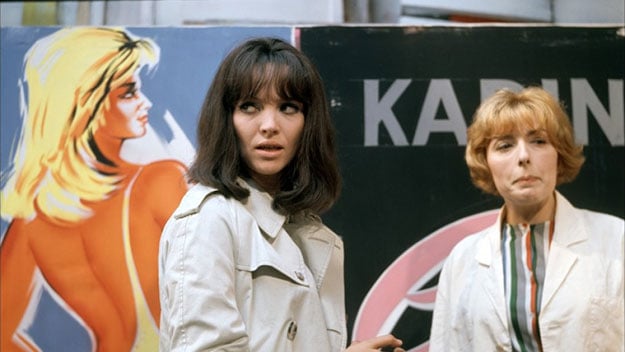
Made in U.S.A.
In 1967, the New York Film Festival turned five—already old enough to have become a yearly ritual for New Yorkers who eagerly awaited the announcement of the titles via an advertisement in the New York Times Arts & Leisure section, and also old enough to have established certain traditions that persist to this day. Then, as now, the festival’s main slate was rigorously curated by a selection committee with an emphasis on international cinema, and by 1967, the festival had already begun to program a few panels and a tiny handful of revivals (Abel Gance’s Napoleon, Rouben Mamoulian’s Applause, and King Vidor’s Show People). But, as longtime selection committee member Phillip Lopate noted in a historical essay published to coincide with the festival’s 50th anniversary, in 1967 neither the Film Society of Lincoln Center nor Alice Tully Hall, which would become the festival’s main venue, existed yet (each film got a single showing in the 2,300-seat theater then known as Philharmonic Hall), and the NYFF functioned as a kind of passionate film club—an event that allowed movie lovers to overrun the newly built Lincoln Center for two weeks every year before they were again banished.
In its early years, the festival had established itself as fiercely highbrow, devotedly Francophilic, and largely uninterested in what Hollywood had to offer. A movie by an American filmmaker could make the cut if it felt political (Sidney Lumet’s Fail-Safe) or French-influenced (Arthur Penn’s Mickey One) or independent (Michael Roemer’s Nothing But a Man). But those were exceptions to an unwritten rule that was only reinforced when Susan Sontag began her decade-long stint on the selection committee in 1967. Sontag’s appreciation of film was passionate, her tastes were austere, even severe, and her certainty that politics belonged on the screen and in the festival was intractable. So it’s not surprising that 1967’s opening-night selection was Gillo Pontecorvo’s The Battle of Algiers—nor was it a shock that of the two dozen movies chosen for that year’s lineup, three were directed by Jean-Luc Godard. Godard’s work would show in nine of the first 10 New York Film Festivals; he was like a top-seeded tennis player who got a bye that sent him straight to the finals. In 1967, the committee grabbed his 1962 film Les Carabiniers, Made in U.S.A. (an uncredited adaptation of Donald Westlake’s mystery The Jugger that ran into rights issues and would prove hard to see in the U.S. for decades), and Far from Vietnam, an antiwar documentary he made with five other directors (including Agnès Varda, the sole member of the class of ’67 to be represented in the 2017 festival as well). Writing in the New York Times when Far from Vietnam opened commercially for a mere one-week run a year later, Renata Adler dismissed its “easy ironies” and the “serene banality” of its narration and said it had “been overtaken by events…the last thing we need now is political stereotypes in a rage.”
It’s doubtful that posterity had been on the minds of the selection committee when they watched Far from Vietnam; they filled the festival with what excited them that minute, which is probably the right way to go—including for posterity’s sake. If one mark of a successful festival is that it include at least one film and one filmmaker that will still be talked about 50 years hence, the inclusions of Battle of Algiers and a Godard mini-fest turn out to have ticked off those boxes. It does the rest of the festival no discredit to call it a mixed bag—ultimately, that’s what all lineups are. Of the two American movies that made the cut, one, Shirley Clarke’s documentary Portrait of Jason, is now rightly understood as a milestone of both cinema vérité and LGBT representation and was named to the Library of Congress’s National Film Registry two years ago. The other, John Korty’s comedy Funnyman, about an improv troupe, is barely remembered. (Korty went on to a solid career in television as the director of movies like The Autobiography of Miss Jane Pittman, and would come to be recognized as an innovator in animation, making 1983’s Twice Upon a Time.)
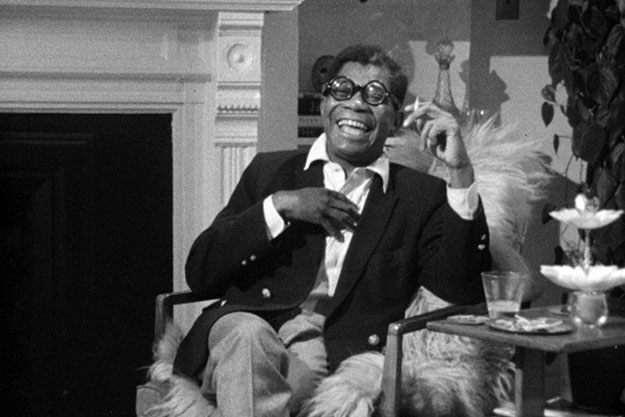
Portrait of Jason
Could the selectors have done more to look at American films with a slightly less skeptical eye? Possibly. It’s easy to imagine them turning their noses up at, say, Richard Brooks’s In Cold Blood or Stuart Rosenberg’s Cool Hand Luke, both of which would have been credible choices. But they were also, as all committees are, at the mercy of what was available: The Graduate wasn’t finished yet, and Warner Brothers had chosen to launch Bonnie and Clyde (a Nouvelle Vague–inflected film that might well have excited the committee) a month earlier at the Montreal Film Festival.
The rest of the 1967 lineup included a few movies that endure via Criterion Collection: Volker Schlöndorff’s adaptation of Robert Musil’s Young Törless, Roberto Rossellini’s The Taking of Power by Louis XIV, and Masaki Kobayashi’s Samurai Rebellion. The most lavishly praised and commercially successful of the foreign selections was Bo Widerberg’s Elvira Madigan; critics and moviegoers swooned over its soft-focus, sun-dappled images of backlit blond hair and its gauzy gaze at 19th-century lovers strolling through lush fields, but within a few years the film’s look had been so thoroughly appropriated by everything from Hollywood movies to shampoo commercials that the original itself had come to seem steeped in cliché. There are a couple of perfect period artifacts, like the concert-interview compilation Tonite Let’s All Make Love in London, with Pink Floyd, John Lennon, Yoko Ono, Allen Ginsberg, Mick Jagger, and Julie Christie (presented by the festival as part of a swinging-London double feature). Dusan Makavejev’s Love Affair, or The Case of the Missing Switchboard Operator, combined boundary-pushing (for the time) nudity and sexuality with a collage-like style mixing documentary and drama, politics and romance, tragedy and playfulness in a way that still feels innovative. And there were two films, Barrier and Le Départ, from the Polish director Jerzy Skolimowski, whose Deep End has become a much-loved repertory pick (and whose Four Nights with Anna screened in the 2008 edition of NYFF).
But honesty requires me to confess that there were movies in the 1967 New York Film Festival I can’t even pretend to know anything about. What to say about Jonas Cornell’s debut film Hugs and Kisses, a Swedish movie (original title: Puss & Kram) that has a mere 24 votes on IMDB, a discouraging rating of 4.2, and the unpromising plot logline “After many entanglements Max’s girlfriend Eva begins to favor John over Max”? Or The Other One, directed by René Allio, whose previous film The Shameless Old Lady had had some art-house success? This follow-up did not: its single showing (“Completely humorless”—The New York Times) seems to have sealed its fate. But at least for one night, it found an audience that really wanted to be there. It is difficult, in the era of DVD and Blu-ray, streaming, and one-touch availability, to imagine that if you didn’t see a movie at a festival, you might have missed your only chance. But 50 years ago, that sense of urgency fueled cinephile culture. The festival’s mission was to sweep the world for the best of international cinema and to bring it to the Upper West Side for two weeks every September and October—just as it is for the 55th edition of the festival this year. But in 1967, its implicit warning was: you may never get another chance.
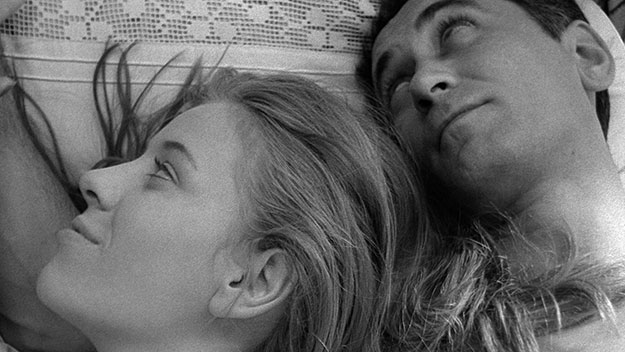
Love Affair, or The Case of the Missing Switchboard Operator
Here, with notes on availability, is the 5th New York Film Festival lineup:
The Battle of Algiers, Gillo Pontecorvo (DVD, Blu-ray, streaming on several services including Filmstruck)
Benefit of the Doubt, Peter Whitehead (unavailable)
Barrier, Jerzy Skolimowski (available only on Region 2 and 3 DVDs)
Les Carabiniers, Jean-Luc Godard (DVD is out of print but used copies are available on Amazon)
Le Départ, Jerzy Skolimowski (available only on Region 2 and 3 DVD)
Elvira Madigan, Bo Widerberg (DVD)
Far from Vietnam, Jean-Luc Godard, Joris Ivens, William Klein, Claude Lelouch, Alain Resnais, and Agnès Varda (DVD, streaming on Fandor)
Father, István Szábo (DVD; streams on Vimeo and Amazon)
The Feverish Years, Dragoslav Lazic (unavailable)
Funnyman, John Korty (unavailable)
Hugs and Kisses, Jonas Cornell (unavailable)
The Lion Hunters, Jean Rouch (available in forthcoming DVD from Icarus)
Love Affair, or The Case of the Missing Switchboard Operator, aka An Affair of the Heart, Dusan Makavejev (DVD, as part of the Eclipse collection Dusan Makavejev: Free Radical)
Made in U.S.A., Jean-Luc Godard (DVD)
Memorandum, Donald Brittain and John Spotton (streams on the National Film Board of Canada’s website)
The Other One, René Allio (unavailable)
Portrait of Jason, Shirley Clarke (DVD, streams on Fandor and Filmstruck)
Samurai Rebellion, Masaki Kobayashi (DVD)
Sons and Mothers, Mark Donskoi (unavailable)
The Taking of Power by Louis XIV, Roberto Rossellini (DVD)
Tonite Let’s All Make Love in London, Peter Whitehead (streams on Vimeo)
Yesterday Girl, directed by Alexander Kluge (DVD, streams on YouTube)
Young Törless, directed by Volker Schlöndorff (DVD)
Mark Harris is the author of Pictures at a Revolution: Five Movies and the Birth of the New Hollywood (2008) and Five Came Back (2014).



